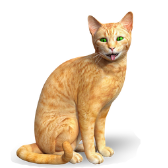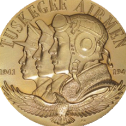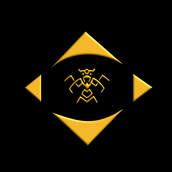-
Posts
401 -
Joined
-
Last visited
Reputation Activity
-
 crabtrem got a reaction from dehskins in Simple Cartoon Effect
crabtrem got a reaction from dehskins in Simple Cartoon Effect
I haven't seen this before, so I figured I would share. This is a simple cartoon like effect. This is similar to the pseudo cell shading tutorial by Affinity, but that's because they used the edge detect tool too. So for what it's worth here we go.
First copy your background layer, CMD-J
Go to Filter, Detect, Detect Edges. Set the blend mode to subtract.
Add the adjustment layer, posterize. Adjust the levels for taste. My example uses 4.
That's it. Now you have a basic cartoon stylized picture. You can use all sorts of additional methods from here. But this seems a good starting point. Hope you find something useful in this. Cheers.
-
 crabtrem got a reaction from Cmak in Simple Cartoon Effect
crabtrem got a reaction from Cmak in Simple Cartoon Effect
I haven't seen this before, so I figured I would share. This is a simple cartoon like effect. This is similar to the pseudo cell shading tutorial by Affinity, but that's because they used the edge detect tool too. So for what it's worth here we go.
First copy your background layer, CMD-J
Go to Filter, Detect, Detect Edges. Set the blend mode to subtract.
Add the adjustment layer, posterize. Adjust the levels for taste. My example uses 4.
That's it. Now you have a basic cartoon stylized picture. You can use all sorts of additional methods from here. But this seems a good starting point. Hope you find something useful in this. Cheers.
-
 crabtrem got a reaction from Lillibit in Is there an offset filter, or a way to wrap around an image?
crabtrem got a reaction from Lillibit in Is there an offset filter, or a way to wrap around an image?
Affinity actually put out a very good tutorial on this here,
. There count is up to 180 videos on Vimeo. A good place to look in addition to the site's tutorial section here. I prefer to go straight to their Vimeo account. -
 crabtrem got a reaction from Longfield75 in Simple Cartoon Effect
crabtrem got a reaction from Longfield75 in Simple Cartoon Effect
I haven't seen this before, so I figured I would share. This is a simple cartoon like effect. This is similar to the pseudo cell shading tutorial by Affinity, but that's because they used the edge detect tool too. So for what it's worth here we go.
First copy your background layer, CMD-J
Go to Filter, Detect, Detect Edges. Set the blend mode to subtract.
Add the adjustment layer, posterize. Adjust the levels for taste. My example uses 4.
That's it. Now you have a basic cartoon stylized picture. You can use all sorts of additional methods from here. But this seems a good starting point. Hope you find something useful in this. Cheers.
-
 crabtrem got a reaction from PaulEC in Simple Cartoon Effect
crabtrem got a reaction from PaulEC in Simple Cartoon Effect
I haven't seen this before, so I figured I would share. This is a simple cartoon like effect. This is similar to the pseudo cell shading tutorial by Affinity, but that's because they used the edge detect tool too. So for what it's worth here we go.
First copy your background layer, CMD-J
Go to Filter, Detect, Detect Edges. Set the blend mode to subtract.
Add the adjustment layer, posterize. Adjust the levels for taste. My example uses 4.
That's it. Now you have a basic cartoon stylized picture. You can use all sorts of additional methods from here. But this seems a good starting point. Hope you find something useful in this. Cheers.
-
 crabtrem got a reaction from ober in Drawing a rectangular grid
crabtrem got a reaction from ober in Drawing a rectangular grid
I would personally recommend using the Designer snapping options, combined with power duplicate to get some powerful results.
Here is a short Affinity tutorial on some power duplicate capabilities.
-
 crabtrem got a reaction from yveslae in Simple Cartoon Effect
crabtrem got a reaction from yveslae in Simple Cartoon Effect
I haven't seen this before, so I figured I would share. This is a simple cartoon like effect. This is similar to the pseudo cell shading tutorial by Affinity, but that's because they used the edge detect tool too. So for what it's worth here we go.
First copy your background layer, CMD-J
Go to Filter, Detect, Detect Edges. Set the blend mode to subtract.
Add the adjustment layer, posterize. Adjust the levels for taste. My example uses 4.
That's it. Now you have a basic cartoon stylized picture. You can use all sorts of additional methods from here. But this seems a good starting point. Hope you find something useful in this. Cheers.
-
 crabtrem got a reaction from BadrAsi in change color in multiple layers at once
crabtrem got a reaction from BadrAsi in change color in multiple layers at once
I'm not that experienced with using them, but from what I have seen, I believe setting and using global colors would be the method I would use.
-
 crabtrem got a reaction from Yeseniamnz in Simple Cartoon Effect
crabtrem got a reaction from Yeseniamnz in Simple Cartoon Effect
I haven't seen this before, so I figured I would share. This is a simple cartoon like effect. This is similar to the pseudo cell shading tutorial by Affinity, but that's because they used the edge detect tool too. So for what it's worth here we go.
First copy your background layer, CMD-J
Go to Filter, Detect, Detect Edges. Set the blend mode to subtract.
Add the adjustment layer, posterize. Adjust the levels for taste. My example uses 4.
That's it. Now you have a basic cartoon stylized picture. You can use all sorts of additional methods from here. But this seems a good starting point. Hope you find something useful in this. Cheers.
-
 crabtrem got a reaction from Kiarian in Affinity Photo duotone setting
crabtrem got a reaction from Kiarian in Affinity Photo duotone setting
Just to be sure. I wanted to highlight these tutorials. You may find them helpful.
-
 crabtrem got a reaction from Uwe367 in Simple Cartoon Effect
crabtrem got a reaction from Uwe367 in Simple Cartoon Effect
I haven't seen this before, so I figured I would share. This is a simple cartoon like effect. This is similar to the pseudo cell shading tutorial by Affinity, but that's because they used the edge detect tool too. So for what it's worth here we go.
First copy your background layer, CMD-J
Go to Filter, Detect, Detect Edges. Set the blend mode to subtract.
Add the adjustment layer, posterize. Adjust the levels for taste. My example uses 4.
That's it. Now you have a basic cartoon stylized picture. You can use all sorts of additional methods from here. But this seems a good starting point. Hope you find something useful in this. Cheers.
-
 crabtrem got a reaction from JPT0908 in Simple Cartoon Effect
crabtrem got a reaction from JPT0908 in Simple Cartoon Effect
I haven't seen this before, so I figured I would share. This is a simple cartoon like effect. This is similar to the pseudo cell shading tutorial by Affinity, but that's because they used the edge detect tool too. So for what it's worth here we go.
First copy your background layer, CMD-J
Go to Filter, Detect, Detect Edges. Set the blend mode to subtract.
Add the adjustment layer, posterize. Adjust the levels for taste. My example uses 4.
That's it. Now you have a basic cartoon stylized picture. You can use all sorts of additional methods from here. But this seems a good starting point. Hope you find something useful in this. Cheers.
-
 crabtrem got a reaction from Steps in Simple Cartoon Effect
crabtrem got a reaction from Steps in Simple Cartoon Effect
I haven't seen this before, so I figured I would share. This is a simple cartoon like effect. This is similar to the pseudo cell shading tutorial by Affinity, but that's because they used the edge detect tool too. So for what it's worth here we go.
First copy your background layer, CMD-J
Go to Filter, Detect, Detect Edges. Set the blend mode to subtract.
Add the adjustment layer, posterize. Adjust the levels for taste. My example uses 4.
That's it. Now you have a basic cartoon stylized picture. You can use all sorts of additional methods from here. But this seems a good starting point. Hope you find something useful in this. Cheers.
-
 crabtrem got a reaction from Shyamaprasad Joshi in 300 dpi export shows as 72 dpi in PhotoShop
crabtrem got a reaction from Shyamaprasad Joshi in 300 dpi export shows as 72 dpi in PhotoShop
Have you watched this tutorial from Affinity?
It may help your situation.
-
 crabtrem reacted to acapstick in LEGACY: Official Affinity Photo (Desktop) Video Tutorials
crabtrem reacted to acapstick in LEGACY: Official Affinity Photo (Desktop) Video Tutorials
DEPRECATED THREAD
The Photo tutorials listed below have been refreshed and moved. Please see this new thread or use the Affinity site Photo Desktop tutorials webpage
In support of our fantastic photo editing app, please use this comprehensive and structured set of videos for accelerated learning!
The video tutorials are available on Vimeo and YouTube via these links:
Vimeo - http://affin.co/PhotoVids
YouTube - http://affin.co/photoyt
We now have a specific Beginners Series of videos tailored to absolute beginners, with a more manageable pacing and focus on concepts and straightforward procedures. They all include subtitles to aid understanding.
The tutorial set includes:
Beginners Series
Opening & Saving - YouTube / Vimeo Layers - YouTube / Vimeo Adjustments - YouTube / Vimeo Filters - YouTube / Vimeo Exporting - YouTube / Vimeo
Introduction
Discover Affinity Photo Getting Started Technical Benefits
Basics
Document Setup Layer Concepts Layers Overview Live Filter Layers Scaling and Transforming Cutting Out Understanding DPI Accessing Help
Transforming
Document/Image Resizing Canvas Resizing Cropping: Practical Cropping: Aesthetic Straightening Images Cropping: Golden Spiral Cropping: Options Aligning Images
Selections and Masking
Making Selections Refining Selections Pixel Selections from Layers Quick Masks Mask Layers Exposure Merging Clipping vs Masking Vector Masking Using Adjustment Layers on Masks - YouTube / Vimeo
Correction
Adjustment Layers Levels Curves Shadows/Highlights Split Toning and Selective Colour LAB Colour Mode Defringing and Chromatic Aberration Live Perspective Haze Removal FFT Denoise Removing Lens Flares Changing Eye Colour Graduated ND Filter Effect Salvaging Underexposed Images Dual Perspective Correction Perspective Skew Correction - YouTube / Vimeo (New: 20th April)
Retouching
Cloning Inpainting Frequency Separation Liquify: Retouching Vector-Based Retouching Enhancing Landscapes/Architecture Vector Architecture: Worked Example Enhancing Camera Phone Photography Making Images Pop Revealing Sky Detail Bringing Out Water Detail Quick Inpainting Crooked Horizons - YouTube / Vimeo
RAW Development
Raw: Discover Develop Raw: Developing Images Raw: Overlays Raw: Redeveloping Images Raw: Noise Reduction Maximising Raw Latitude Custom Tone Curve Raw Development Quality 32-bit Raw Development - YouTube / Vimeo Raw Colour Quality Automatic Lens Corrections Raw: Recovering Overexposed Highlights Raw: Exposure Bias
Getting Creative
Lighting Creative Gradients Creative Black & White Sepia Images Brushes Blend Modes Blend Ranges Liquify Persona Sky Replacement Adding Borders Text: Branding/Watermarking Diffuse Glow Displacement Circular Bokeh Swirling Bokeh Simulating Ambient Occlusion Texturing with Blend Modes Creating Atmosphere Creating Light Beams Vector Lighting Simple Gradients Technicolor Emulation - YouTube / Vimeo Creative Painting Colour toning with shapes Infrared Emulation Radial Blur Regular Tone Mapping Compositing Landscapes Adding Extended Borders Creating Photo Collages Abstract Ideas #01 Abstract Ideas #02 Enhancing Low Light Trails Light Painting Compositing Tone Mapping Portraits HSL Tonal Separation - YouTube / Vimeo Orton Effect - YouTube / Vimeo
Design Aids
Snapshots Modifiers Designer/Photo Interworking Pixel Accurate Design Placing Documents Useful Keyboard Shortcuts Non Destructive Inpainting and Cloning Layer Creation Behaviour Layer Nesting Exporting 3D LUTs LUTs for Tonal Adjustments View Points Global Cloning Subtle Toning Multiple Colour Formats Scopes Curves Picker Non-Destructive Dodge & Burn Flexible Defringing Edge Detection for Masking Split & Mirror View Batch Processing Clone Sources Pixel Art Resize Direct PSD write-back (round tripping) Freehand Selection Tool Undo History Importing .abr Brushes Undo Brush with Snapshots Quick Toggling Panels - YouTube / Vimeo Light UI - YouTube / Vimeo Brush Stabilisation - YouTube / Vimeo
Channels
Channels Channels for Alpha Masking Channels: Creating/Storing Selections Editing Single Channels Channels: Greyscale Blending Channel Packing
Filters
Live Filter Layers (Also in Basics) Apply Image Apply Image: Equations Equations Filter Dust & Scratches Filter Halftone Scanlines Effect Mirror filter Diffuse Glow Filter Defeating Filter Limits
Panoramas
Panoramas Tricky Panoramas Panorama Distortion Correction
HDR (High Dynamic Range)
HDR: Merging & Tone Mapping HDR from one exposure - YouTube / Vimeo HDR: Tone Map Presets HDR: Panoramas HDR: Preprocessing HDR: Advanced Editing HDR: Ghosts Removal HDR: 32-bit Editing
Focus Merging (Focus Stacking)
Focus Merging Focus Merge Retouching Focus Merging Bracketed Exposures
Live Stacking
Maximum Stacking Big Stopper Effect Light Painting Blending Stacking: Long Exposure Simulation Stacking: Noise Reduction Stacking: Object Removal Stacking: Exposure Merging Stacking: Star Trail Effect
Live Projections (360 editing, perspective projection)
360 Live Editing - YouTube / Vimeo 360 Advanced Editing 360 Retouching 360 Multiple Views 360 Roll Correction - YouTube / Vimeo Live Perspective Projection
OpenEXR/32-bit
OpenEXR Multichannel Import/Export OpenEXR Import Options Editing 32-bit 3D Renders OpenEXR: Using Alpha Channels & Association
3D Render/Texture Work
Seamless Textures Clone Sources: Texture Creation Enhancing 3D Renders #01 Enhancing 3D Renders #02 Tone Mapping 3D Renders 3D Relighting with Normal Map Passes - YouTube / Vimeo
Colour Management
OpenColorIO Setup OpenColorIO Adjustment Soft Proofing Printing on Mac Printing on Windows Wide Colour Profiles vs sRGB - YouTube / Vimeo
Macros
Macros Macros: Equations Macros: Layer Behaviour Batch Processing with Macros
Finishing Off
Sharpening Selective Sharpening Exporting Export Compression Efficiency
Plugins
Installing Nik Plugins (macOS) Installing Nik Plugins (Windows) Installing & Using Nik Dfine
Projects
Nature Portrait Supermoon Product Shot Retouching #01 Nighttime Architecture Workflow - YouTube / Vimeo Portrait Retouching Workflow - YouTube / Vimeo
Bonus Content
Uplift Epic Skies (1.6 Bonus Content) - YouTube / Vimeo
Windows Workflow videos
In addition to the regular tutorials, we've also got some workflow videos shot on the Windows version of Photo that cover using a variety of features to edit an image to completion. These tend to be released on a more informal basis.
Hadrian's Wall Tiled Building Portrait Retouching Monochromatic Architecture Canary Wharf Banded Demoiselle
Please let us know about areas you think need covering, have problems with, don’t understand, or just tell us if we’re on the right or wrong track. Simply reply to this pinned topic.
Have fun with Affinity Photo!
Best wishes from the Affinity Documentation Team!
-
 crabtrem got a reaction from joseGaitan in Simple Cartoon Effect
crabtrem got a reaction from joseGaitan in Simple Cartoon Effect
I haven't seen this before, so I figured I would share. This is a simple cartoon like effect. This is similar to the pseudo cell shading tutorial by Affinity, but that's because they used the edge detect tool too. So for what it's worth here we go.
First copy your background layer, CMD-J
Go to Filter, Detect, Detect Edges. Set the blend mode to subtract.
Add the adjustment layer, posterize. Adjust the levels for taste. My example uses 4.
That's it. Now you have a basic cartoon stylized picture. You can use all sorts of additional methods from here. But this seems a good starting point. Hope you find something useful in this. Cheers.
-
 crabtrem got a reaction from adirusf in Simple Cartoon Effect
crabtrem got a reaction from adirusf in Simple Cartoon Effect
I haven't seen this before, so I figured I would share. This is a simple cartoon like effect. This is similar to the pseudo cell shading tutorial by Affinity, but that's because they used the edge detect tool too. So for what it's worth here we go.
First copy your background layer, CMD-J
Go to Filter, Detect, Detect Edges. Set the blend mode to subtract.
Add the adjustment layer, posterize. Adjust the levels for taste. My example uses 4.
That's it. Now you have a basic cartoon stylized picture. You can use all sorts of additional methods from here. But this seems a good starting point. Hope you find something useful in this. Cheers.
-
 crabtrem got a reaction from joeycastellon in Blurring background?
crabtrem got a reaction from joeycastellon in Blurring background?
Have you tried using the FX on the rectangular object? There is a Gaussian Blur FX, along with some others you might also consider. You could also place a Live Filter on the rectangle too. But I find the FX are often overlooked and under appreciated.
-
 crabtrem got a reaction from Father ODD Creations in Simple Cartoon Effect
crabtrem got a reaction from Father ODD Creations in Simple Cartoon Effect
I haven't seen this before, so I figured I would share. This is a simple cartoon like effect. This is similar to the pseudo cell shading tutorial by Affinity, but that's because they used the edge detect tool too. So for what it's worth here we go.
First copy your background layer, CMD-J
Go to Filter, Detect, Detect Edges. Set the blend mode to subtract.
Add the adjustment layer, posterize. Adjust the levels for taste. My example uses 4.
That's it. Now you have a basic cartoon stylized picture. You can use all sorts of additional methods from here. But this seems a good starting point. Hope you find something useful in this. Cheers.
-
 crabtrem got a reaction from jamesholden in Is it possible to constrain a line to certain measurements, and still adjust the curve?
crabtrem got a reaction from jamesholden in Is it possible to constrain a line to certain measurements, and still adjust the curve?
Hello,
Sorry it is me again. I looked at your file. I don't know if you will be happy with my resolution. Please bear in mind, this is only my opinion. And that I am no expert, just a self taught tinkerer.
Okay. That being said. Here are the limits I set upon myself in dealing with this.
First. The paper size is absolute. You have an A4 paper selected. The dimensions are 21cm by 29.7 cm.
Second. The size requirement for the letters being 25cm were absolute.
So, the only way to do this is to put each letter on a separate paper.
This is what I did. And here is the YouTube link for the video I made for it. Forgive the no edits, and no sound.
https://youtu.be/s44_WdmxLDc
So the first thing I did was look at the paper size by hitting the document setup button.
I changed the measurements to centimeters, since that's our base measurement.
I changed the orientation of the document to portrait so I had more room in the Vertical to work with.
I then selected my Artboard tool, and made the document into an Artboard.
I hit the Insert Artboard button 2 more times to create 2 more A4 sheets on my document.
I went to view and turned on the grid. I went to View and opened the Grid and Axis Manager Up.
I deselected the Automatic Grid. Kept the Mode to Standard, and checked the Uniform box. I am happy with a 1cm square grid size, so I don't change anything.
I need to make sure my Snap to Grid is on.
Now I am going to do each letter separately. You may be able to select them all and do it in one shot. But for today we will just do each letter separately.
I select the first letter. Go to the transform tab, make sure the chain in linked between the H and W. And I set 25cm into the Height box.
I position my letter.
I go to my next letter and do the same. This time dragging it to the second Artboard. Then repeat for the Third letter.
And there you go. All you letters are 25cm in height and placed on an A4 sized paper. But in this case I had to put each letter on a separate sheet of paper.
I don't think I forgot anything.
Hopefully you can find some use in these techniques. Good luck. Thank you very much for your very gracious words for my other video. Success.
-
 crabtrem got a reaction from mtjoseph in Simple Cartoon Effect
crabtrem got a reaction from mtjoseph in Simple Cartoon Effect
I haven't seen this before, so I figured I would share. This is a simple cartoon like effect. This is similar to the pseudo cell shading tutorial by Affinity, but that's because they used the edge detect tool too. So for what it's worth here we go.
First copy your background layer, CMD-J
Go to Filter, Detect, Detect Edges. Set the blend mode to subtract.
Add the adjustment layer, posterize. Adjust the levels for taste. My example uses 4.
That's it. Now you have a basic cartoon stylized picture. You can use all sorts of additional methods from here. But this seems a good starting point. Hope you find something useful in this. Cheers.
-
 crabtrem got a reaction from Goldblacc in Simple Cartoon Effect
crabtrem got a reaction from Goldblacc in Simple Cartoon Effect
I haven't seen this before, so I figured I would share. This is a simple cartoon like effect. This is similar to the pseudo cell shading tutorial by Affinity, but that's because they used the edge detect tool too. So for what it's worth here we go.
First copy your background layer, CMD-J
Go to Filter, Detect, Detect Edges. Set the blend mode to subtract.
Add the adjustment layer, posterize. Adjust the levels for taste. My example uses 4.
That's it. Now you have a basic cartoon stylized picture. You can use all sorts of additional methods from here. But this seems a good starting point. Hope you find something useful in this. Cheers.
-
 crabtrem got a reaction from jrr52 in Simple Cartoon Effect
crabtrem got a reaction from jrr52 in Simple Cartoon Effect
I haven't seen this before, so I figured I would share. This is a simple cartoon like effect. This is similar to the pseudo cell shading tutorial by Affinity, but that's because they used the edge detect tool too. So for what it's worth here we go.
First copy your background layer, CMD-J
Go to Filter, Detect, Detect Edges. Set the blend mode to subtract.
Add the adjustment layer, posterize. Adjust the levels for taste. My example uses 4.
That's it. Now you have a basic cartoon stylized picture. You can use all sorts of additional methods from here. But this seems a good starting point. Hope you find something useful in this. Cheers.
-
 crabtrem got a reaction from Affinity Revolution in Simple Cartoon Effect
crabtrem got a reaction from Affinity Revolution in Simple Cartoon Effect
I haven't seen this before, so I figured I would share. This is a simple cartoon like effect. This is similar to the pseudo cell shading tutorial by Affinity, but that's because they used the edge detect tool too. So for what it's worth here we go.
First copy your background layer, CMD-J
Go to Filter, Detect, Detect Edges. Set the blend mode to subtract.
Add the adjustment layer, posterize. Adjust the levels for taste. My example uses 4.
That's it. Now you have a basic cartoon stylized picture. You can use all sorts of additional methods from here. But this seems a good starting point. Hope you find something useful in this. Cheers.
-
 crabtrem got a reaction from Foura in Simple Cartoon Effect
crabtrem got a reaction from Foura in Simple Cartoon Effect
I haven't seen this before, so I figured I would share. This is a simple cartoon like effect. This is similar to the pseudo cell shading tutorial by Affinity, but that's because they used the edge detect tool too. So for what it's worth here we go.
First copy your background layer, CMD-J
Go to Filter, Detect, Detect Edges. Set the blend mode to subtract.
Add the adjustment layer, posterize. Adjust the levels for taste. My example uses 4.
That's it. Now you have a basic cartoon stylized picture. You can use all sorts of additional methods from here. But this seems a good starting point. Hope you find something useful in this. Cheers.










